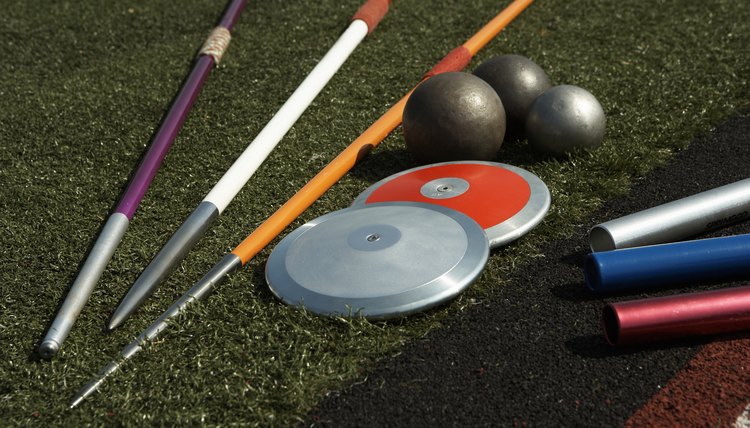How to Make a Discus Throwing Sector

The long sides of a discus throwing sector are set apart at an angle of 34.92 degrees. That may sound precise and difficult to attain, but if you create an isosceles triangle, three simple measurements will make the task easy. The short side of the triangle is 60 percent of the length of the two equal, longer sides. So grab three friends -- A, B and C -- and create an isosceles triangle to make the perfect sector.
Locate and mark the center of the discus throwing circle. Use your thumb or foot to pin one end of a 200-foot tape measure to the center of the ring and hold it there.
Have friend A walk the other end of the tape measure down one side of the throwing area, stopping at 200 feet. Pull the tape measure tight so it is as straight as possible. Drive a stake into the ground at the 200-foot mark.
Measure the short side of the triangle. Instruct friend B to hold one end of another 200-foot tape measure to the base of the stake. Have friend C walk the other end of the new tape measure out across the throwing field, measuring and holding the tape measure at 120 feet.
Find the other long side of the triangle. Tell friend A, still holding the end of the tape measure anchored in the center of the circle, to hold it tight at the 200-foot mark and walk away from the stake to the other side of the throwing field.
When friends A (long side) and C (short side) meet up at the spot where the 200-foot mark on one tape meets the 120-foot mark on the other tape, you've found the other vertex of the triangle. Drive a stake into the ground where the tape measures meet, making sure they are both pulled tight.
Roll the tape measures up and put them away. Tie string to one of the stakes and run it to the center of the circle, pulling it tight and straight. Spray paint the ground along the string.
Repeat for the other stake. Remove the stakes.
Tips
If you don't expect throws of 200 feet or more, you can reduce the size of the vector. Just make sure to keep a 5:3 ratio for the small side of the isosceles triangle. For example, if you make the long sides of the triangle 100 feet, you'd need to make the small side 60 feet.
Tips
- If you don't expect throws of 200 feet or more, you can reduce the size of the vector. Just make sure to keep a 5:3 ratio for the small side of the isosceles triangle. For example, if you make the long sides of the triangle 100 feet, you'd need to make the small side 60 feet.
Writer Bio
Christopher Michael began writing in 2010 for Break.com. He received a Bachelor of Arts in English from the University of Massachusetts, Amherst. Writing sports and travel articles helps support his professional baseball career, which has taken him to 49 states, five continents and four oceans.
